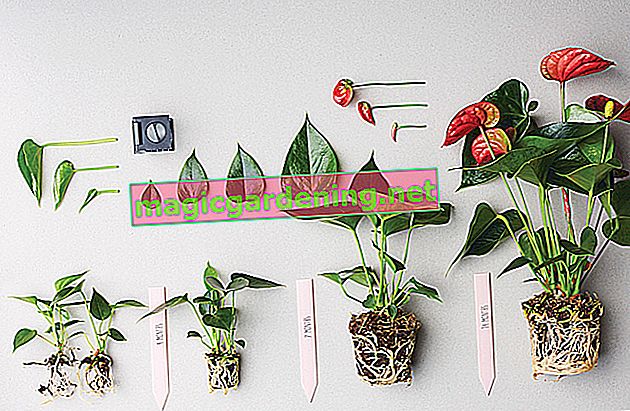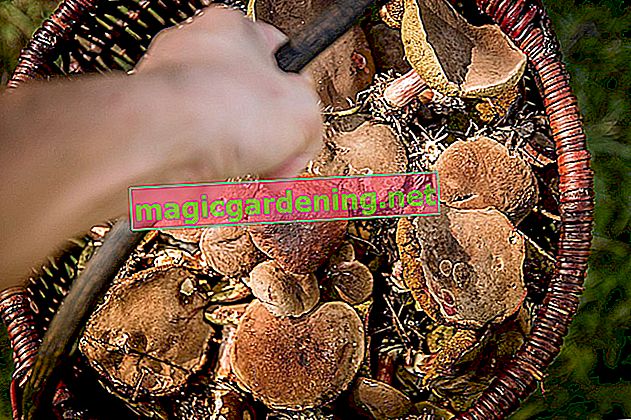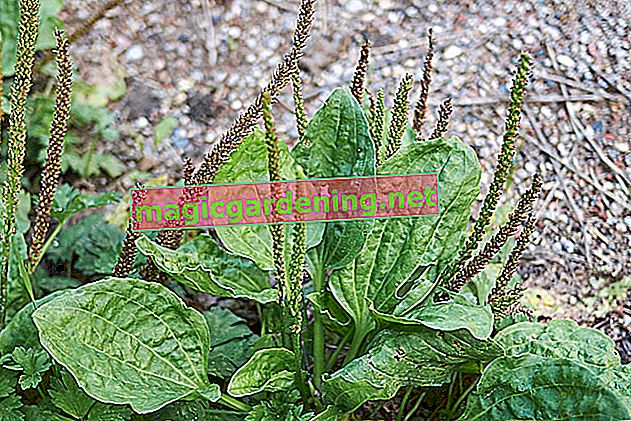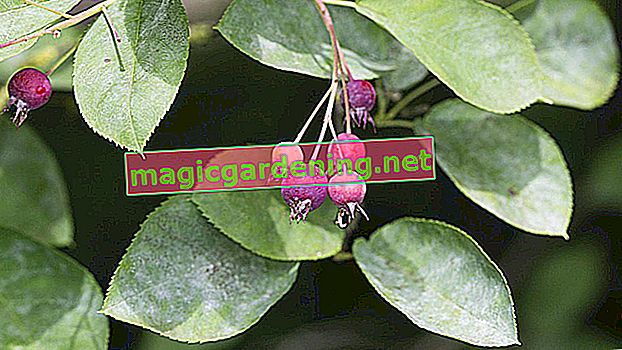
origin
The genus of the flamingo flowers (Anthurium) comprises about 600 to 1000 different species that are native to the tropical rainforests of Central and South America and the Caribbean islands. Here the evergreen, perennial plants mostly grow epiphytically like orchids, ie as epiphytic plants on the huge jungle trees. Few species have roots in the earth.
also read
- Caring for the great flamingo flower (anthurium andreanum)
- Is the great flamingo flower (anthurium andreanum) poisonous?
- Which anthurium varieties are cultivated as house plants?
use
In this country, hybrids of the two species large flamingo flower (Anthurium andreanum) and small flamingo flower (Anthurium scherzerianum) are mainly cultivated as houseplant, occasionally one of the two species mentioned as well as Anthurium crystallinum. The latter is a seldom cared for species with broad, heart-shaped leaves with a metallic red sheen.
Growth and size
Flamingo flowers grow clumpy, form long stems with large leaves. On average, the plants are between 40 and 100 centimeters high and 30 to 60 centimeters wide, but can also become significantly larger and more extensive with age. Their size depends largely on their location and the growing and care conditions. The bushy houseplant is particularly popular because of its brightly colored foliage, which is usually bright red. However, there are also pink, orange and white variants.
Flowering and flowering period
These colored bracts are often mistaken for the flower decoration, but the actual flowers are quite unspectacular. Only the bulb in the middle of the splendid bracts represents the flower. This can be straight or curved and colored red, orange or yellow. Anthurium hybrids basically bloom all year round; average blooming times of up to 300 days per year are not uncommon with good care. Only the small flamingo flower (Anthurium Scherzerianum) shows its often very lush colors only between May and June.
leaves
The leaves of the anthurium hybrids can look very different, depending on which genetic material comes through. In most of the commercially available varieties, the dark green, glossy foliage is long-stalked and elongated-heart-shaped. Elongated, lanceolate shapes are also possible. The colored bracts or bracts (the botanist speaks of "spathe") have egg, heart-shaped or oval shape and are sometimes characterized by deep bulges.
fruit
When grown indoors, anthurium produces fruits extremely seldom because of the lack of pollination. This is especially true if it is a hybrid - and therefore sterile - variety. In their natural location, on the other hand, the plants develop inconspicuous berry fruits from the flowers, which contain tiny seeds about the size of grains.
root
The fleshy, compact rhizome of the flamingo flower doesn't take up much space, which is why the planter only needs to be slightly larger than the root ball. The long leaf and flower stalks grow directly out of the roots and do not branch among each other or above ground.
Is anthurium poisonous?
As a member of the arum family (Araceae), anthurium is naturally poisonous for humans and animals. The leaves in particular contain oxalic acid and insoluble calcium oxalate crystals, which irritate the mucous membranes and can lead to typical symptoms of poisoning such as nausea, diarrhea, vomiting, etc. However, the signs of disease usually subside after a few hours, since the plants are only classified as slightly toxic. However, the Bonn Information Center against Poisoning still advises you to consult a doctor, as the toxicity levels can vary greatly from plant to plant and a critical dose is not yet known. It is also advised to drink plenty of water to dilute the toxins and clear them out through the digestive tract as quickly as possible.
Which location is suitable?
In their natural location, anthuriums grow in the shade of the large jungle trees. At home, you should reproduce these conditions as closely as possible by keeping the plants out of direct sun - this can quickly lead to ugly leaf burns, especially on south-facing windows. However, the space must be bright, which is why you should carefully check the conditions in your home. If the window in question faces east or west, the anthurium can also stand on the window sill, provided it can be protected from the midday sun that may be burning in during the summer months. If, on the other hand, the window faces south, you should place the plant at least a meter away and definitely shade it over the midday hours. Larger,sun-loving plants on the window sill or trees standing outside.
Caution is advised in winter if the anthurium should stand on a window sill: In many apartments there are radiators underneath, the warm and dry air of which the flamingo flower cannot tolerate. Instead, as a typical rainforest plant, it requires high humidity, which is why it is often best kept in the bathroom. In addition, she does not like drafts (e.g. next to frequently opened windows) and feels most comfortable when temperatures remain constant between 20 and 25 ° C all year round.
Substrate
Place the flamingo flower in a loose, well-drained and humus-rich substrate. A high-quality, commercially available potting soil is completely sufficient here. In addition, the plants can be kept in hydroponics, in which they often feel much more comfortable.
Propagate anthurium
The easiest way to reproduce anthuriums is by dividing them, if possible in spring. Proceed as follows:
- Lift the plant out of the pot.
- Carefully remove the adhering earth.
- Now carefully pull or cut the root ball into at least two parts.
- Take a close look at the root ball beforehand.
- The best places to split can be easily identified.
- Always use a sharp and clean knife for cutting if possible!
- Then plant the individual parts in individual pots with fresh substrate.
- Pour them penetratively and continue grooming them as usual.
Larger plants also often develop kindles that simply have to be carefully separated and planted separately. Furthermore, propagation is also possible via cuttings and sowing, but both are not without pitfalls and take a lot of time.
Cuttings
To propagate cuttings, use young leaves with existing roots, which you can recognize by the small knots on the stem. Carefully separate these leaves from the mother plant without damaging the nodes and place them in a glass with fresh, warm water. Place the glass in a bright (but not directly sunny!) And warm location. Change the water daily and don't forget to clean the glass of any deposits. The young anthuriums are only potted when they have developed enough roots.
sowing
If you discover small white berries on the flower head of your anthurium, it is time to act quickly. The seeds in it - if they are capable of germinating at all - have to get into the ground quickly, as they can only reproduce for a short time. Open the berries and wash the slimy pulp carefully. This contains germ-inhibiting substances and must therefore be removed. Then place the few seeds in a seed tray filled with sand, whereby the grains must not be covered as light germs. Spray the substrate with the seeds and keep them evenly moist for the coming weeks. Make the air tense by placing the seed trays in an indoor greenhouse or covering them with translucent film. Put the bowl in a warm and bright place,make sure there is sufficient moisture and ventilate the cover regularly. Germination should take place after two weeks at the latest, although the failure rate is very high.
Water anthurium
Anthuriums depend on an even water supply and should not dry out. If the plant is kept too dry, only a few flowers will develop or the existing ones will be thrown off. Make sure that the substrate is always slightly damp, but not permanently wet. The plant also does not tolerate waterlogging and then develops root rot after a short time, which is usually fatal. A good pot drainage is therefore essential, excess irrigation water should be able to drain away unhindered. Remove this from pots and saucers after a few minutes to save the plant "wet feet".
Use the softest water possible for watering, as anthuriums are quite sensitive to lime. If there is no rainwater available, stale tap water is also very suitable. However, it shouldn't be cold, but room temperature - or do you like to take a cold shower? Furthermore, the plant should be sprayed or showered from time to time with room warm water. This not only removes the layer of dust on the leaves - which in turn hinders photosynthesis - but also ensures higher humidity.
Fertilize anthurium properly
As a flowering plant, anthuriums need a lot of nutrients, but are very sensitive to salts. For this reason, you should fertilize frequently, but only in small amounts. If possible, use a liquid complete fertilizer for indoor or flowering plants, which you add to the irrigation water in half the recommended concentration and which you administer weekly during the summer months. In winter, however, one fertilization per month is sufficient.
Repot
Plant young flamingo flowers in a larger pot every spring with fresh substrate. Older, fully grown specimens, on the other hand, no longer need to be repotted, but here you can rejuvenate them by dividing them. If this is not what you want, just replace the substrate in spring.
Cut the anthurium properly
In principle, cutting measures are not necessary. You should only remove discolored or dried out leaves and dead flower stems directly at the roots with sharp and clean scissors or a small knife.
Overwinter
During the winter months, anthuriums should be placed in a light place at slightly cooler temperatures between 16 and 20 ° C, and watering and fertilization are now less frequent. In this way, the development of flowers can also be encouraged in rotten specimens.
Diseases
The glossy leaves of the flamingo flower are coated with a layer of wax that keeps many pests and pathogens away from the outset. In fact, many symptoms are less due to fungi or viruses and more to poor care. Waterlogging or a substrate that is permanently too moist not only makes the earth go moldy, but also rot the roots. In this situation, the only way to save is quick repotting in fresh, dry substrate, combined with a strong pruning of the roots and above-ground parts of the plant.
As long as your anthurium has shiny, dark green leaves without any discoloration and also keeps developing new flowers, it will feel good. In this case, leave them in place and continue to care for them as before.
Yellow leaves
If the leaves turn yellow, the anthurium is often too light. This is especially the case when the plant is right next to a window. Place it a little further away so that it comes out of direct sun but is still bright. Remove the discolored leaves with scissors or a knife; they will not turn green again.
Brown leaves / brown leaf spots
If the leaf edges curl up, if the leaves develop brown spots or if entire leaves turn brown, then your anthurium is likely to suffer from a lack of water. The root ball must not dry out, which is why you should carry out the finger test regularly: If the substrate feels dry on the surface, it is time for watering. On the other hand, if the soil is still damp, you should wait a few more days.
Pests
The flamingo flower is also quite resistant to pests. Only spider mites and scale insects can cause problems for the plant from time to time. Spider mites, also known as red spiders, only appear when the air is too dry and can be easily driven away by increasing the humidity. Scale insects, on the other hand, are simply wiped off with a damp cloth and a little washing-up liquid.
Anthurium does not bloom, what to do?
If the anthurium does not want to bloom properly, it is probably lacking nutrients. If you fertilize the plant regularly, the first flowers should soon appear. Another reason for blooming laziness is a location that is too dark - moving to a lighter place helps.
Tips
The flower stalks of the flamingo flower can also be arranged as cut flowers in the vase, either in a mixed bouquet or alone. Change the water regularly and place the vessel in a light, not drafty location, then you can enjoy the colorful splendor for two to three weeks.
sorts
The most popular hybrid varieties of anthurium include:
- 'Acropolis': creamy white flowers
- 'Baron': pink flowers
- 'Cheers': pink flowers
- 'Fantasia': cream-colored flowers
- 'Midori': green flowers
- 'Otazu': red-brown flowers
- 'Pistace': light green flowers
- 'Rosee Choco': dark red flowers








